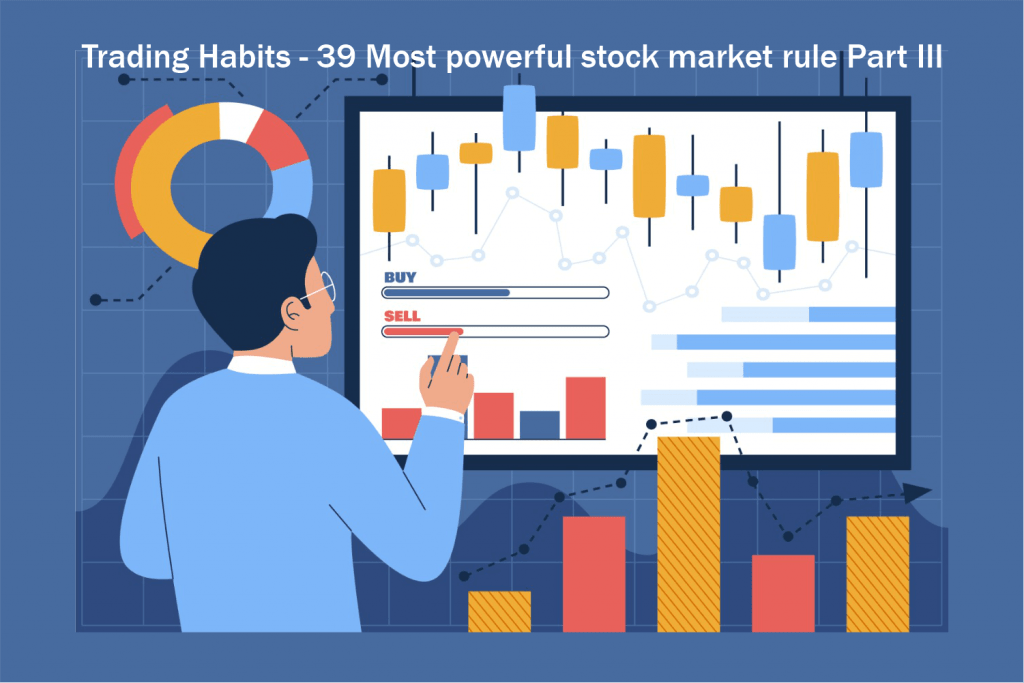This article is the summary of the book Trading Habits 39 Most Powerful Stock Market Rules By Steve Burns & Holly Burns. The article is divided into three parts based on its major segments and we will discuss rules 28 to 39 in this part.
If You missed the first two parts of this summary then check the below links:
Trading 39 Most Powerful Stock Market Rules Part 1
39 Most Powerful Stock Market Rules Part 2
Trading Rule 28-39 Part 3
The Keys to Profitability
28. Manage losses and maximize gains.
Stop losses is the one thing that can stop you from having huge losses. A stop-loss is the cost of insurance you pay to avoid being caught on the wrong side of a large market trend. Get in the habit of knowing where your stop loss will be before you enter a trade.
29. The key to long-term survival and prosperity has a lot to do with the money management techniques incorporated into the technical system. – Ed Seykota
It is position sizing, and not the brilliance of entries and exits, that will determine a trader’s long-term profitability. The odds are that if your system is bad enough to allow for a 50% drawdown, then you will be at zero before you can recover.
30. Be disciplined in risk management and flexible in perceiving market behavior. – Richard Weissman
Risk management is the discipline of doing what you planned to do, without deviation. Once a stop loss is chosen, it must be set in stone. A stop-loss set at a close below the 30 RSI or the 200-day moving average is a low-probability event inside a bull market uptrend.
31. Position sizing can be correlated to the quality of a trade setup
Long-term traders should have some top-notch trade setups that have the highest probability of success. It is a better strategy to risk your maximum position size on your best setups, and your smallest on your less likely trades. Mastering this strategy will dramatically improve your performance.
Now move towards the further stock market rules
32. Never lose more than 1% of your total trading capital on any one trade.
The 1% rule does not mean only trading with 1% of your trading capital. If you’re trading a $100,000 account, then no losing trade should ever be over $1,000. With this rule, you don’t have to fear big drawdowns or account blowups.
33. First find the right stop loss level that will show you that you’re wrong about a trade, then set your position size based on that price level.
If you buy 500 shares of Apple at $120 and the key support level is at $118 near the 200-day moving average, then the 1% rule makes sense. You don’t want your stop to be too tight; stop losses in obvious places tend to be taken out. I use end-of-day stops and smaller position sizes to avoid the majority of the intraday noise.
34. Never lose more than 3% of your total trading capital on your worst day.
I recommend that you never have more than three trades open at any one time. You’re relatively safe if, on your worst day when all your trades go against you, you’re only down 3%. At that point, you still have the opportunity to capture a market trend.
35. When I am trading poorly, I keep reducing my position size. That way, I will be trading my smallest position size when my trading is worst. – Paul Tudor Jones
Traders usually have losing streaks because the market environment has changed from volatile to not volatile. The worse you’re trading, the smaller your trades should be. Conversely, you should be at your maximum position size during winning streaks. To maximize your current opportunity or minimize the potential for losses, adjust your position sizing and risk exposure.
36. Losers average losers.
It is a deadly habit for a trader to average down on a losing trade when they are already proven wrong. Being rewarded for this behavior with a rally will just reinforce the bad habit. Getting in the habit of learning from the experience and moving on to the next trade is key.
37. Never allow a statistically significant unrealized gain to turn into a statistically significant realized loss. – Richard Weissman
There is a window of opportunity for locking in gains, and you have to establish parameters for this. If you’re long the $SPY as it approaches the 70 RSI, it’s a good time to look at locking in a profit. Never allow a big winning trade to reverse and turn into a losing trade.
The further and last two but equally important stock market rules are.
38. Understand the nature of instability and adjust your position size for the increased risk due to volatility spikes.
Know the trading range of your stock or index over the last ten days and position size accordingly. You should be able to handle a 50% increase in a trading range without having a devastating loss. Always manage risk and be ready to adjust quickly when faced with volatile markets.
39. Place your stop losses outside the range of noise so you’re only stopped out when you’re wrong:
Find the price level for your stop-loss that has a high probability of never being hit. Position size correctly so the worst-case scenario is a small loss. Get in the habit of finding low-probability stop losses as much as high-probability sets.
Check Out our Post on RSI which will help you to get a better understanding of the technical aspect of trading, Click the Below link.

